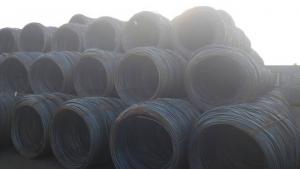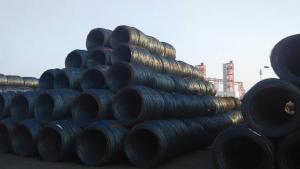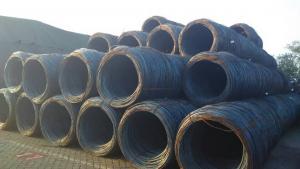Steel Wire Rod with High Quality
- Loading Port:
- China Main Port
- Payment Terms:
- TT or LC
- Min Order Qty:
- 100 m.t.
- Supply Capability:
- 5000MT m.t./month
OKorder Service Pledge
OKorder Financial Service
You Might Also Like
Product Description:
OKorder is offering Steel Wire Rod with High Quality at great prices with worldwide shipping. Our supplier is a world-class manufacturer of steel, with our products utilized the world over. OKorder annually supplies products to African, South American and Asian markets. We provide quotations within 24 hours of receiving an inquiry and guarantee competitive prices.
Product Applications:
Steel Wire Rod with High Quality are ideal for structural applications and are used in reinforcement of reinforced concrete and welded structure or reprocessed (Roberts, nails etc) materials, especially used to produce wire drawing, welding electrode, nails, spring, electronic, precise machinery parts and so on.
Product Advantages:
OKorder's Steel Wire Rod with High Quality are durable, strong, and wide variety of sizes.
Main Product Features:
· Premium quality
· Prompt delivery & seaworthy packing (30 days after receiving deposit)
· Can be recycled and reused
· Mill test certification
· Professional Service
· Competitive pricing
Product Specifications:
Manufacture: Hot rolled
Grade: Q195 – 235
Size:5.5mm, 6.5mm, 8mm, 10mm, 12mm
Certificates: ISO, SGS, BV, CIQ
Packaging: Export packing, nude packing in coil
Coil weight:1.95-2.05MT
FAQ:
Q1: Why buy Materials & Equipment from OKorder.com?
A1: All products offered byOKorder.com are carefully selected from China's most reliable manufacturing enterprises. Through its ISO certifications, OKorder.com adheres to the highest standards and a commitment to supply chain safety and customer satisfaction.
Q2: How do we guarantee the quality of our products?
A2: We have established an advanced quality management system which conducts strict quality tests at every step, from raw materials to the final product. At the same time, we provide extensive follow-up service assurances as required.
Q3: How soon can we receive the product after purchase?
A3: Within three days of placing an order, we will arrange production. The normal sizes with the normal grade can be produced within one month. The specific shipping date is dependent upon international and government factors, the delivery to international main port about 45-60days.
Images:
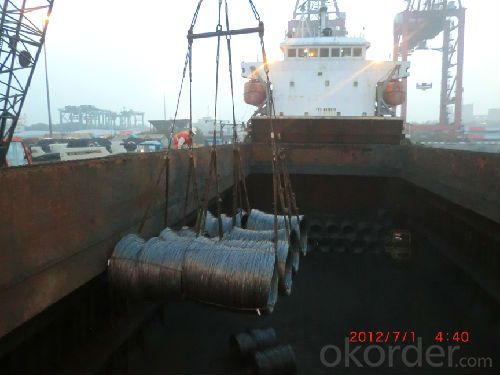
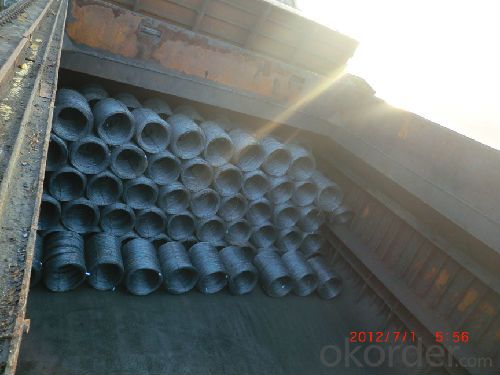

- Q:What are the strength requirements for steel wire rod used in suspension bridge wire strands?
- The strength criteria for steel wire rod utilized in the wire strands of suspension bridges can differ based on various factors. Typically, the wire rod must possess a high level of tensile strength to endure the immense loads and stresses that suspension bridges encounter. The wire rod must have a minimum yield strength and ultimate tensile strength that either meets or surpasses the design requirements for the suspension bridge. The yield strength signifies the amount of stress that the wire rod can tolerate before it permanently deforms, while the ultimate tensile strength indicates the maximum stress the wire rod can withstand before it breaks. In addition to high strength, the wire rod must also demonstrate good ductility and toughness. Ductility refers to the material's ability to deform without fracturing, while toughness is its capacity to absorb energy without fracturing. These properties are vital for maintaining the structural integrity of the wire strands, as they allow the strands to flex and absorb dynamic loads, such as wind or vehicle vibrations, without experiencing failure. Furthermore, the wire rod should possess excellent corrosion resistance to ensure the longevity and durability of the suspension bridge. Over time, corrosion can weaken the wire strands, which compromises the bridge's structural integrity. Therefore, the wire rod must have a protective coating or be composed of corrosion-resistant alloys that can withstand exposure to environmental factors like moisture, saltwater, and pollutants. Lastly, the wire rod's dimensional requirements, including its diameter and surface finish, must also adhere to the specifications of the suspension bridge design. These dimensions are crucial for maintaining the desired strength and performance characteristics of the wire strands. In conclusion, the strength requirements for steel wire rod used in suspension bridge wire strands encompass high tensile strength, good ductility, toughness, corrosion resistance, and compliance with dimensional specifications. By meeting these requirements, the wire strands are capable of withstanding the significant loads and environmental conditions experienced by suspension bridges, ensuring their structural integrity and safety.
- Q:What are the main factors affecting the market branding of steel wire rod?
- The main factors affecting the market branding of steel wire rod include quality and performance standards, price competitiveness, brand reputation and customer trust, technological advancements and innovation, market demand and trends, and the ability to provide customized solutions and value-added services.
- Q:What are the different types of steel wire rod surface finishes after wire drawing?
- Wire drawing can result in various surface finishes for steel wire rods. These finishes serve multiple purposes, such as improving wire performance, safeguarding it from corrosion, and protecting it from environmental factors. Here are some commonly used surface finishes for steel wire rods: 1. Bright finish: After wire drawing, the wire retains its natural state, resulting in a shiny, reflective surface. This finish is suitable for applications where aesthetics are not a primary concern. 2. Galvanized finish: To prevent corrosion, the wire is coated with a layer of zinc. Galvanized wire has a matte appearance and is commonly utilized in outdoor settings exposed to moisture and harsh conditions. 3. Phosphated finish: Through a chemical process called phosphating, the wire receives a phosphate coating that enhances its corrosion resistance and adhesion properties. This finish is ideal for applications involving high temperatures or corrosive environments. 4. Coated finish: A protective layer of polymer or another material is applied to the wire's surface. Coated wire possesses a smooth, uniform appearance and is often used when insulation or abrasion protection is necessary. 5. Nickel-plated finish: The wire undergoes a process where it is coated with a layer of nickel. This finish enhances corrosion resistance and improves the wire's appearance, resulting in a bright, shiny surface. Nickel-plated wire is frequently employed in decorative applications or environments exposed to moisture and corrosive substances. These examples demonstrate the variety of steel wire rod surface finishes obtainable after wire drawing. The selection of a specific finish depends on the application's requirements and the desired properties of the wire.
- Q:How is the steel wire rod market segmented by application?
- The steel wire rod market is segmented by application based on the various industries that utilize steel wire rods for different purposes. Some of the main segments in this market include construction, automotive, energy, industrial, and others. In the construction sector, steel wire rods are commonly used for reinforcement in concrete structures, such as buildings, bridges, and highways. These rods provide strength and durability to the structures, making them resistant to various forces and enhancing their overall stability. The automotive industry also heavily relies on steel wire rods for manufacturing various components, including springs, suspension systems, and wire harnesses. The high tensile strength of steel wire rods makes them ideal for these applications as they can withstand the demanding conditions in automotive systems. The energy sector is another significant segment for steel wire rods, particularly in the production of power transmission cables and electrical wiring. Steel wire rods are used to manufacture conductors that efficiently transport electricity over long distances while maintaining minimal loss. In the industrial sector, steel wire rods find applications in a wide range of industries, including machinery, appliances, and manufacturing. These rods are utilized for producing fasteners, bolts, nuts, and other mechanical components that require strength and reliability. Apart from these major segments, there are other applications of steel wire rods in sectors like agriculture, aerospace, and consumer goods. For instance, in agriculture, steel wire rods are used for fencing, trellising, and supporting structures. In aerospace, they are utilized for manufacturing aircraft cables, suspension systems, and other critical components. Overall, the steel wire rod market is segmented by application based on the diverse needs of different industries. The versatility and strength of steel wire rods make them a crucial material in various sectors, enabling the development of robust and reliable products.
- Q:How is steel wire rod used in the manufacturing of wire for 3D printing?
- In the process of manufacturing wire for 3D printing, steel wire rod serves as a vital component. It is utilized as the primary material for producing top-notch wire that finds application in various sectors within the 3D printing industry. To initiate the process, the suitability of steel wire rod for manufacturing is ensured through a series of rigorous quality control checks. These checks involve thorough examination of the rod's chemical composition, mechanical properties, and surface condition. Once the rod successfully passes these tests, it is considered appropriate for further processing. Subsequently, the steel wire rod is fed into a wire drawing machine, where it undergoes a procedure known as wire drawing. In this procedure, the rod is pulled through progressively smaller dies, resulting in the reduction of its diameter and an increase in its length. This process aids in enhancing the wire's surface finish and dimensional accuracy. Following the wire drawing stage, the steel wire undergoes additional processing to eliminate any impurities or contaminants present on its surface. This is accomplished through a process called pickling, wherein the wire is immersed in an acid solution to dissolve any oxides or scales that may have formed during wire drawing. This guarantees that the wire is clean and ready for subsequent manufacturing steps. The final step in the production of wire for 3D printing entails coating the steel wire with a layer of polymer or metal alloy. This coating serves multiple purposes, including improving the wire's adhesion to the printing bed, enhancing its durability, and providing a smooth surface finish to the 3D printed object. To summarize, steel wire rod plays a critical role in the manufacturing process of wire for 3D printing. Its exceptional tensile strength, remarkable mechanical properties, and ability to withstand high temperatures make it an ideal choice for producing wire that meets the demanding requirements of the 3D printing industry.
- Q:How is steel wire rod manufactured?
- Steel wire rod is manufactured through a process called hot rolling, which involves passing a billet or a slab of steel through a series of rolling mills. These mills compress and shape the steel into a long, continuous rod with a specific diameter. The rod is then cooled and coiled, ready to be used in various applications such as construction, automotive, and manufacturing industries.
- Q:How is steel wire rod used in the manufacturing of wire for electrical cables?
- Steel wire rod is a crucial raw material used in the manufacturing of wire for electrical cables. It serves as the base material from which the wire is drawn and formed. The steel wire rod is subjected to a series of processes, including drawing, annealing, and coating, to transform it into a wire with the desired electrical conductivity and strength. This wire is then further processed and insulated to create electrical cables that are widely used in various applications, such as power transmission, telecommunications, and wiring installations.
- Q:What are the common types of internal defects in steel wire rod?
- Some common types of internal defects in steel wire rod include inclusions, segregations, cracks, and voids. Inclusions are foreign substances that are trapped within the steel during the manufacturing process. Segregations occur when the composition of the steel is not uniform, resulting in areas with different properties. Cracks can occur due to excessive stress or improper cooling during production. Voids are empty spaces or cavities within the steel. These defects can weaken the wire rod and affect its overall quality and performance.
- Q:How are steel wire rods used in the production of piano wire?
- Steel wire rods are used in the production of piano wire by being drawn through a series of dies to gradually reduce their diameter. This process, known as wire drawing, results in a long, thin, and high-tensile strength wire that is then coiled, hardened, and tempered to create the strong and resilient piano wire used in piano strings.
- Q:How is steel wire rod used in the production of nails and screws?
- Nails and screws heavily rely on steel wire rod as a vital raw material. This exceptionally strong and durable material serves as the base for manufacturing these fasteners. To enhance its properties, the steel wire rod undergoes a series of mechanical and heat treatments. In the nail production process, the steel wire rod goes through a wire drawing machine to reduce its diameter and increase its length. This step not only improves the wire's tensile strength and smoothness but also elongates it. After being drawn, the wire is cut into specific lengths and sharpened at the ends to form nail points. Once the nails take shape, they undergo a heat treatment process called tempering. This involves subjecting them to high temperatures and then rapidly cooling them. The purpose of tempering is to increase the nails' hardness and resistance to bending or breaking, ensuring they can withstand the stress and pressure they'll encounter during use. Similarly, in screw production, the steel wire rod is drawn and cut into specific lengths. These lengths are then threaded by rolling or cutting grooves along the wire's surface, giving the screw its spiraled shape. The threading process adds strength, enabling the screw to securely fasten materials together. The steel wire rod used for nails and screws is usually made from low-carbon, high-carbon, or alloy steel. Each type of steel offers specific properties, such as corrosion resistance or increased strength, depending on the intended application of the fasteners. All in all, steel wire rod plays a vital role in the production of nails and screws. Its strength, durability, and versatility make it an ideal material for these fasteners, ensuring they can effectively hold materials together in various construction, manufacturing, and household applications.
1. Manufacturer Overview |
|
|---|---|
| Location | |
| Year Established | |
| Annual Output Value | |
| Main Markets | |
| Company Certifications | |
2. Manufacturer Certificates |
|
|---|---|
| a) Certification Name | |
| Range | |
| Reference | |
| Validity Period | |
3. Manufacturer Capability |
|
|---|---|
| a)Trade Capacity | |
| Nearest Port | |
| Export Percentage | |
| No.of Employees in Trade Department | |
| Language Spoken: | |
| b)Factory Information | |
| Factory Size: | |
| No. of Production Lines | |
| Contract Manufacturing | |
| Product Price Range | |
Send your message to us
Steel Wire Rod with High Quality
- Loading Port:
- China Main Port
- Payment Terms:
- TT or LC
- Min Order Qty:
- 100 m.t.
- Supply Capability:
- 5000MT m.t./month
OKorder Service Pledge
OKorder Financial Service
Similar products
New products
Hot products
Related keywords
